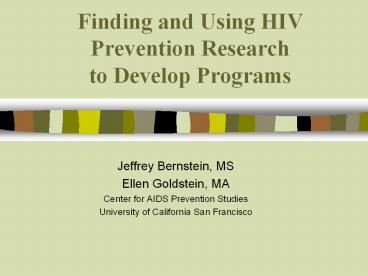Finding and Using HIV Prevention Research to Develop Programs - PowerPoint PPT Presentation
1 / 20
Title:
Finding and Using HIV Prevention Research to Develop Programs
Description:
Finding and Using HIV Prevention Research to Develop Programs Jeffrey Bernstein, MS Ellen Goldstein, MA Center for AIDS Prevention Studies University of California ... – PowerPoint PPT presentation
Number of Views:122
Avg rating:3.0/5.0
Title: Finding and Using HIV Prevention Research to Develop Programs
1
Finding and Using HIV Prevention Research to
Develop Programs
- Jeffrey Bernstein, MS
- Ellen Goldstein, MA
- Center for AIDS Prevention Studies
- University of California San Francisco
2
Take Home Message
- HIV prevention research is more than just
evidence-based interventions. - Using research for program design is an ongoing,
full-agency activity. - Using research findings and methods can lead to
more specific, successful programs.
3
What is HIV prevention research?
- Epidemiological data
- Basic behavioral science
- Behavioral change theory
- Evidence-based programs
- Evaluation methods
4
Epidemiology
- Describes the number of people (i.e., prevalence
of disease or behavior) - 35 of Latino MSM CSW in the neighborhood are
HIV - 20 of IDUs in your community have used NEP
- So What?
- If you knew that a segment of the community had
not tested, you might want to increase outreach
for your testing program.
5
Basic Behavioral Science
- Studies to understand mechanisms by which
behaviors are acquired - Depression is a co-factor in transmission.
- Traditional gender roles in young people are
associated with higher sexual risk behavior. - So What?
- If you knew this, you might want to train your
case managers to assess for depression and make
appropriate referrals.
6
Behavioral Change Theory
- Describes how behaviors change
- Health Belief Model Perceived susceptibility
perceived severity perceived benefits of
behavior perceived barriers of the behavior. - So What?
- A program would want to include elements that
help clients address all four areas.
7
Evidence-based Programs
- Rigorously evaluated interventions
- Example Popular Opinion Leader or MPowerment
- So What?
- New programs can replicate efficacy of model
programs. - New grants can be written to fund model programs
at the agency.
8
Evaluation Methods
- Techniques for understanding people and programs
- Example Formative, process, outcome, or impact
evaluations conducted at the agency. - So What?
- An agencys own data can be used by agency staff
to develop new programs, modify existing
programs, or discontinue outdated programs.
9
Activity Use it or Lose it
- Using the Research
- in Program Design
10
Additional Information
- Epidemiology
- 40 of all new HIV cases here are among MSM
between the ages of 30-35. - A recent behavioral surveillance study showed
that 60 of MSM reported drug use (speed,
crystal, crack,) during their last episode of
UAI.
11
Additional Information
- Basic behavioral science
- Persons who experience incidents of sexual abuse
during childhood and adolescence are at a
significantly higher risk of mental health
problems and HIV risk behavior. A study of adult
gay and bisexual men found that those who had
been abused were much more likely to engage in
unprotected anal intercourse and injection drug
use.
12
Additional Information
- Behavioral change theory
- Stages of Change theory is based on the premise
that behavior change occurs in stages. Movement
through the stage varies from person to person
and group to group. The process is not linear and
often includes relapse. - Pre-contemplation, contemplation, preparation
action, maintenance
13
Additional Information
- Evidence-based programs
- The 1999 CDC Compendium includes interventions
for MSM. (See handout) - Do any of these look useful? Or not?
14
Additional Information
- Evaluation methods
- You have just received funding to do a formative
evaluation a series of 3 focus groups to ask
members of the population about their program
needs. What questions might you want to include
in the focus group guide?
15
Where do you find the research?
16
Where can you find research?
- www.caps.ucsf.edu
17
Where can you find research?
- CTAP brochure
- Visit our website for a list of California and
National resources in English and Spanish - www.caps.ucsf.edu/CTAP
18
Criteria for evaluating what you find
- Does the research resonate what you already know
about your clients/ community (through your
experience or because you did your own research)?
- Does the research answer a question you have
about your clients/ community that you can
confirm with your community?
19
Criteria Evaluated Programs
- Is it feasible in your agency setting?
- Is there buy-in from all parts of the agency?
- Are there adequate resources committed?
- Is there staff training?
- What other resources in the community are
available for this need?
20
Take Home Message
- HIV prevention research is more than just
evidence-based interventions. - Using research for program design is an ongoing,
full-agency activity. - Using research findings and methods can lead to
more specific, successful programs.































